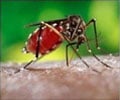Scientists on Wednesday said they had cracked the genetic codes of a major malaria parasite and a monkey parasite also suspected of spreading the disease, an achievement adding to
Scientists on Wednesday said they had cracked the genetic codes of a major malaria parasite and a monkey parasite also suspected of spreading the disease, an achievement adding to the sequencing six years ago of Plasmodium falciparum, the greatest malarial threat.
Studies detailing the two parasites, P. knowlesi and P. vivax, were released by the British-based science journal Nature.Malaria claims more than a million lives a year - 800,000 of them African children aged under five - and sickens hundreds of millions more, according to the World Health Organisation (WHO).
There are four well-known culprits: P. falciparum, P. vivax, P. ovale and P. malariae.
These are parasites spread by the female anopheline mosquito, which hands on the pathogen as it takes a blood meal.
P. vivax is the most widespread parasite, being most prevalent in Asia and the Americas, and is most to blame for recurrent bouts of malaria.
Most fatalities, though, are inflicted by P. falciparum, which is widespread in Africa.
Advertisement
Some experts believe that many cases attributed to P. malariae were in fact caused by P. knowlesi.
Advertisement
Malaria parasites are estimated to have around 5,500 genes clustered in 14 chromosomes, including stealthy mechanisms that can mask the coating of the parasite so that it is not attacked by the immune defences after entering the body.
Genomic sequencing is a powerful medical tool, as it can expose chinks in a pathogen's armour.
In a commentary also published by Nature, malaria expert Elizabeth Winzeler said the sequencing of P. falciparum in 2002 had been a watershed, helping to revive scientific interest and public and private funding for what had become an overlooked disease.
"If basic research continues to be a priority and if support is sustained, new drugs are likely to be developed, and this could make the goal of global malaria eradication achievable," she said.
Source-ANI
LIN













